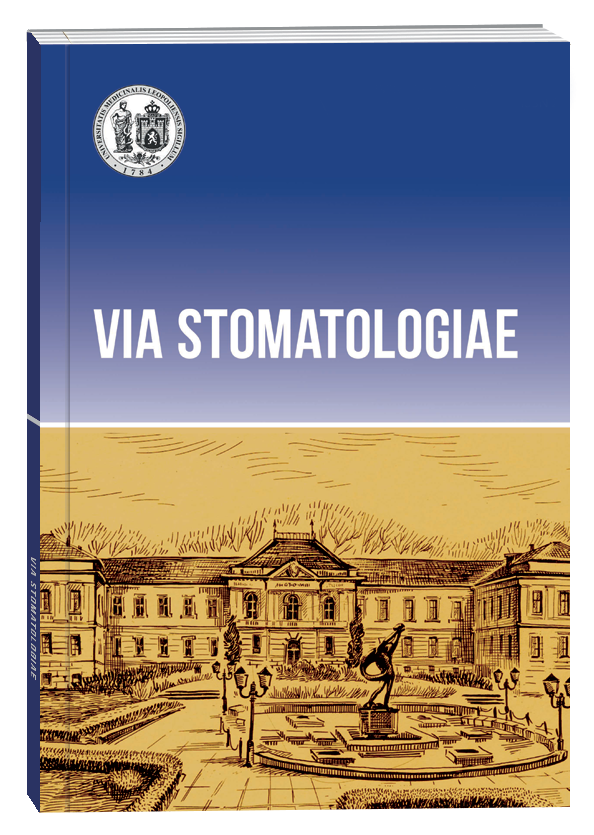EFFECTIVENESS OF ULTRASONOGRAPHY IN DETECTING DISC DISPLACEMENTS AND EFFUSION IN TEMPOROMANDIBULAR JOINTS
DOI:
https://doi.org/10.32782/3041-1394.2024-3.7Keywords:
temporomandibular joint, ultrasonography, magnetic resonance imaging, disc displacement, effusion, sensitivity, specificityAbstract
Introduction. Ultrasonography (US) has gained significant popularity in diagnosing temporomandibular disorders (TMDs). However, the effectiveness of using US for examining the temporomandibular joints (TMJs) to diagnose TMDs, particularly disc displacements (DD) and joint effusion (JE), remains a subject of debate. The aim of the study. To determine the effectiveness of USG in diagnosing disc displacements and effusion in TMJ. Research materials and methods. The study included 33 patients aged 18 to 64 years who underwent US and MRI of the right and left TMJs. Using US, the following parameters were examined to detect DD in TMJs: disc position relative to the condyle with closed teeth in habitual occlusion, ultrasonographic characteristics of condyle movement, disc position relative to the condyle with maximum mouth opening, and for detecting JE: width of the joint space. For diagnosing DD in TMJs and determining its type on MRI, the following parameters were evaluated: disc position relative to the condyle with closed mouth in habitual occlusion (PD pulse sequence), movement of the condyle and disc during mouth opening and closing, disc position relative to the condyle and eminence with maximum mouth opening. MRI examination for detecting JE in TMJs was performed using T2/ FS pulse sequence. Effusion was visualized as individual dots, bands, or a massive area in the TMJ area with high signal intensity. Results. The calculated parameters of US effectiveness in detecting DD in TMJs (overall) were as follows: sensitivity – 57,14%, specificity – 83,33%, overall accuracy – 66,67%, positive predictive value (PPV) – 85,71%, negative predictive value (NPV) – 52,63%. When studying the effectiveness of US depending on the type of DD, the following data were obtained for DD with reduction: sensitivity – 40,00%, specificity – 89,13%, overall accuracy – 74,24%, PPV – 61,5%, NPV – 77,36%. For DD without reduction: sensitivity – 45,45%, specificity – 88,64%, overall accuracy – 74,24%, PPV – 66,67%, NPV – 76,47%. Regarding JE in TMJs: sensitivity – 33,33%, specificity – 91,67%, overall accuracy – 75,76%, PPV – 60,00%, NPV – 78,57%. Conclusions. Considering the sensitivity and specificity of USG for DD with and without reduction and JE of the TMJ (sensitivity was 40, 45,45, 33,33%, respectively, and specificity – 89,13, 88.64, 91,67%), ultrasound is more advisable to use for excluding the mentioned diagnoses rather than confirming them.
References
Клочан С.М. Оцінка поширеності клінічних підгруп скронево- нижньощелепних розладів в обстежених дорослих, їх ґендерний та віковий розподіл. Stomatological Bulletin : scientific and practical journal. 2021. T. 115. № 2. P. 46–52.
Diagnostic Criteria for Temporomandibular Disorders (DC/TMD) for Clinical and Research Applications : Recommendations of the International RDC/TMD Consortium Network* and Orofacial Pain Special Interest Group† / E. Schiffman et al. Journal of Oral & Facial Pain and Headache. 2014. Vol. 28. № 1. P. 6–27.
Examination for the Factors Involving to Joint Effusion in Patients with Temporomandibular Disorders Using Magnetic Resonance Imaging / F. Mizuhashi et al. Journal of Imaging. 2023. Vol. 9. № 5. P. 101.
The Role of Ultrasound in Temporomandibular Joint Disorders: An Update and Future Perspectives / B. Maranini et al. Frontiers in Medicine. 2022. Vol. 9.
Yılmaz D., Kamburoğlu K. Comparison of the effectiveness of high resolution ultrasound with MRI in patients with temporomandibular joint dısorders. Dentomaxillofacial Radiology. 2019. Vol. 48. № 5. P. 20180349.
Diagnostic ultrasound assessment of temporomandibular joints: a systematic review and meta-analysis F.T. Almeida et al. Dentomaxillofacial Radiology. 2019. Vol. 48. № 2. P. 20180144.
Li D.T.S., Leung Y.Y. Temporomandibular disorders: current concepts and controversies in diagnosis and management. Diagnostics. 2021. Vol. 11. № 3. P. 459.
Ultrasonography in the diagnosis of temporomandibular disorders: a metaanalysis / T. Klatkiewicz et al. Medical science monitor. 2018. Vol. 24. P. 812–817.
Iagnocco A. Imaging the joint in osteoarthritis: a place for ultrasound? Best practice & research clinical rheumatology. 2010. Vol. 24. № 1. P. 27–38.
Advanced ultrasound screening for temporomandibular joint (TMJ) internal derangement S.N. Friedman et al. Radiology research and practice. 2020. Vol. 2020. P. 1–10.
Diagnostic value of high-resolution ultrasound for the evaluation of capsular width in temporomandibular joint effusion / D. Talmaceanu et al. Life. 2022. Vol. 12. № 4. P. 477.
Протокол ультрасонографічного обстеження скронево-нижньощелепних суглобів та жувальних м’язів: а. с. 109243 Україна / Р.В. Кулінченко та ін. № c202107215; заявл. 8.10.2021; опубл. 9.11.2021. 2 с.
Можливості сучасного МРТ-обстеження в комплексній діагностиці скронево-нижньощелепних розладів / Д.В. Штибель та ін. Via stomatologiae. 2024. Vol. 1. № 2. P. 56–65
Assessment of MRI findings and clinical symptoms in patients with temporomandibular joint disorders / R. Matsubara et al. Dentomaxillofacial Radiology. 2018. P. 20170412.
Біостатистика / Т. Грузєва та ін. ; ред. Т. Грузєва. Вінниця : Нова кн., 2020. 381 с.
Okeson J.P. Management of temporomandibular disorders and occlusion. Mosby, 2019.
Diagnostic value of ultrasonography for the detection of disc displacements in the temporomandibular joint: a systematic review and meta-analysis / N. Su et al. Clinical oral investigations. 2018. Vol. 22. № 7. P. 2599–2614.
Ultrasonography for detection of disc displacement of temporomandibular joint: a systematic review and meta-analysis / C. Li et al. Journal of oral and maxillofacial surgery. 2012. Vol. 70. № 6. P. 1300–1309.
Liao L.-J., Lo W.-C. High-Resolution sonographic measurement of normal temporomandibular joint and masseter muscle. Journal of medical ultrasound. 2012. Vol. 20. № 2. P. 96–100.
High-resolution ultrasonography in assessing temporomandibular joint disc position / D. Talmaceanu et al. Medical ultrasonography. 2018. Vol. 1. № 1. P. 64.







